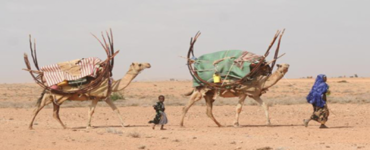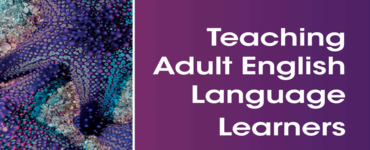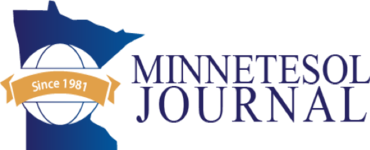Prior knowledge is central to memory and learning, but many older refugees come to the classroom with ways of knowing and experiences much different from what they find in Western teaching contexts. Somali elders offer insight.
Key words: indigenous knowledge, Somali, elders, beginning language and literacy, LESLLA
Almost six years ago, I was working in an affordable housing nonprofit as a coordinator of ESL programs. I was struck by the number of elder learners in the program—their regular attendance in a beginning literacy class impressed upon me a vibrant example of who adult learners are. They often said, “Teacher! Students—no good!,” but this ran counter to what I knew must be vast reserves of prior learning experiences which, because I did not speak Somali, I knew nothing about. I wanted to honor their vitality of mind and spirit in learning through a qualitative study on their prior learning experiences and indigenous knowledge (Vogl, 2019). The stories they shared with me described important lessons that were altogether invisible to me, and which I would like to share in this piece: elder learners’ prior learning experiences, the interplay of indigenous knowledge and cultural dissonance in beginning language and literacy classrooms, and the profound impact of isolation and trauma among refugee learners.
Becoming familiar with the knowledge and experiences our students bring to the classroom is one of the central tenets of adult education theory (Tarone, Bigelow, & Hansen, 2009; TESOL International Association, 2018). This can be most challenging in beginning language and literacy classrooms, where the teacher may not always share a language or cultural background similar to their students’. In this paper, I share narratives from elder learners in order to highlight their knowledge and prior learning experiences. Their knowledge is indigenous knowledge, which is passed down orally through generations, and is specific to the place where they lived.
I focus on one particular subset of learners—Somali elders aged 65 and older participating in a beginning language and literacy classroom in Minnesota. Seven participants had gone to school in the U.S. for more than two years, and of those, six were currently attending school at the time of the study. Of the remaining participants, five had attended school in the U.S. fewer than six months and were not currently attending school, while two had never attended school in the U.S. (Vogl, 2019). In order to understand what happens to the place-based knowledge that these learners possess when they must leave their country, I highlight important findings from a qualitative study of interviews and observations with an instructor and elders (Vogl, 2019), which explored their prior learning experiences in order to illuminate what indigenous knowledge is and how culture dissonance, trauma, and isolation can impact elder learners, in elders’ own words. Finally, while the main findings of this study explored indigenous knowledge and cultural dissonance, I will briefly discuss some approaches that may be useful for teachers to apply with learners of any age.
Elders as Learners
Language learning can be challenging at any age, and the apocryphal belief is that it may become impossible the older you get. But language learning does not stop after childhood (de Bot & Makoni, 2005), and many who register for adult ESL classes are elders. Further compounding our understanding of elders’ needs is the fact that the majority of research on the experiences of refugees in education is focused primarily on younger refugees (Haines, 2010). The research which does focus on elder learners is largely focused on high-income white populations, while minority populations are underrepresented (von Doetinchem de Rande, 2012).
The elders interviewed in this study had not attended school in their home country and were not literate in their first language. In fact, it was not until 1972, when Somali elders of the present day had already reached adulthood, that Somali became the national language and language of instruction. Formal education was limited and intended to further colonization of the country by Britain and Italy (Abdi, 1998). The elders who participated in this study had not gone to school, but instead grew up learning from their elders, in different environments and lifestyles (Vogl, 2019).
Students’ relation to indigenous knowledge is dynamic and subject to shifts in lifestyle and occupation. This is true even for elder learners who, in the case of this group of participants, reached adulthood before being subjected to the upheaval and trauma following the civil war and refugee resettlement process. With this background information, we are able to set the context for indigenous knowledge and how it shapes elder learners’ perception of learning experiences.
What is Indigenous Knowledge?
Many people know things which have aspects reminiscent of indigenous knowledge. For example, perhaps your grandmother showed you how to preserve fruits you grow in the summer and save them for the winter; for others, indigenous knowledge may be the stories and lessons your extended family taught you about the land they grew up on or the neighborhood where they lived. But for most of us who grew up in the U.S., the knowledge we have comes from books, like the canon of American literature or legends of our founding fathers. This knowledge was taught to us in formal settings, and, thanks to standardized education, much of what we know is the same no matter where we live (Semali & Kincheloe, 1999). For elder refugees from Somalia, their knowledge is not found in textbooks—it was passed down orally through generations, and it is specific to the place where they lived (Ahmed, 2014).
As I was having conversations with elder participants, I was most interested in how I, as a teacher, could understand more about their indigenous knowledge as the prior learning experiences that are so valuable to adult learners in any language class. But, indigenous knowledge as an epistemological concept is difficult for outsiders, as I was in this situation, to nail down and to understand. Often, I felt I was at an impasse in the conversations with elders and didn’t know how to ask more questions to find out more. Luckily, one elder explained the differences between text-based learning and indigenous knowledge systems with textbook-like precision:
“You can practice with your parents. You look at your brothers and sisters and mothers and fathers, and your neighbors. How to butcher, how to milk, how to build and move. It’s not something you imagine—it’s something you can watch.”
This quote shows us that, rather than formal classroom learning experiences, elder learners’ indigenous knowledge was based in experiential learning through apprenticeship, and was grounded in the places and lifestyles of elders before coming to the U.S. As educators, we want to know more about our students’ past learning experiences when teaching new skills. Whether our students grew up in the city or in the country, learning through formal or informal education, we must become more familiar with what they know. For many elder refugees, indigenous knowledge is that wealth of information educators need to draw on, and elder learners attest that it is of equal value to text-based learning:
“Everything about the country, you can write. If you don’t know anything, you are a dark person.”
[Do you think country people are dark people?]
“Country is country, city is city, the education is a different way. Everybody knows what they know. No, everything is good.”
[In reference to images of nomadic lifestyles:]
“This is education. This is a building that they build. This is their house. Sometimes they move. Sometimes they build. This is learning. See? It’s learning.”

Most elders interviewed in this study grew up in rural communities rather than cities, and so I explored how learning was different there and how elder learners compared it to formal schooling. The quotes above demonstrate that elders recognize the value in indigenous knowledge and its relevance to formal learning experiences (“Everything about the country, you can write.”). Further, in indigenous societies, elders are living repositories of indigenous knowledge, and they often become teachers themselves (Dubus, 2010). Elders as teachers offer a deep, reflective sensibility and insight into the precariousness and continual conditionality of life (Deloria, 2006; Gadow, 1983). It’s clear that elders have so much to contribute, not only as learners, but as teachers themselves. Thus, student-centered teaching strategies are essential to engaging elders in a way that enables them to share their prior learning experiences.
Indigenous Knowledge and Cultural Dissonance
As a primary tenet of adult learning theory, students’ prior success in learning is paramount to success in the acquisition of new skills (Vinogradov, 2013). However, when students perceive a difference between their prior learning experiences and what they experience in the classroom, this can present cultural dissonance. Cultural dissonance, as was identified by the elder learners in this study, concerns perceived differences in priorities between the students’ ways of knowing and learning and the Western-style, formal educational framework used in the U.S., which can cause a general sense of discord and conflict when confronted with a new cultural model for learning (Marshall & DeCapua, 2013).
Each elder began the interview with a story about their indigenous knowledge and expertise and success in learning prior to coming to the United States. But while each elder identified this knowledge as valid and their learning experiences as successful, many later conceded their belief when asked to talk about their experiences as students in the U.S. And for many, this meant that their prior knowledge could not be valuable to them in their current experience: “English and Somali are different. I didn’t even go to duqsi. All the things I’ve learned wouldn’t help me in English class.”
The profound impact this has on elder learners is real. I was struck in particular by one elder’s account of why she quit going to school. As one elder described to me, “pen and pencil” learning is the only kind that counts as real education:
“He’s an educated person– he’s a teacher. Me, I’m not educated.
[You don’t see all the things you learned as being a resource in your life?]
When you ask me about learning, I always think pen and pencil. But me, I don’t think it was learning. If you want to learn something you have to learn from your brain. I think, “Why do I bother my teacher? I’m not going to bother my teacher.”
[Why do you feel like you’re wasting the teacher’s time?]
People keep going and I’m going behind. And I will stay home. That’s what I decided.
When elders see a difference between the expectations and practices of Western-style, formal education and everything they have learned in their own lives, this presents cultural dissonance. These perceived differences follow elders into the classroom, impacting their self-esteem and raising their affective filter, making it too stressful to learn and affecting their attendance.
Isolation
“Nobody knocks on your door in America. I can’t tell my problems, whatever I have inside.”
In a culture which values individualism and independence like in the United States, elders’ vitality is often measured by how well elders are able to live independently and remain self-sufficient (Clark, 1991). On the other hand, Somali culture, as well as many indigenous cultures throughout the world, is collectivist. While the primary focus of this study was on indigenous knowledge and prior learning experiences, a full portrait of elders’ experiences revealed the profound impact of isolation and trauma on elder refugees.
One elder I interviewed was a favorite classmate and neighbor among everyone we knew. As a gregarious, caring person who kept up with all her neighbors, she taught me by example how living in a community is so important to people at any age, and something which is markedly absent in American society. She described the differences between individualist and collectivist societies in this profound indictment:
Why don’t you know your neighbors? Somali people and our religion say you have to know your neighbors. What did they eat last night? If they didn’t eat, you have to feed them. You have to eat together—that’s what being neighbors means. In America, the only way that they don’t know each other is because there is no trust. When one of their American neighbors dies, how do they go?
Many of the elders in this study, like the speaker above, attested to the profound importance of community. Through his student-centered approach, the teacher in the building where these elder learners lived demonstrated how English class can be a part of the fabric of the community, where neighbors participate in learning together. A student-centered approach is essential to becoming a part of the community. The elder learners in this study were celebrated and welcomed as major participants in class, taking turns at the whiteboard and leading activities.
In addition to isolation, past trauma has a profound impact on elders’ sense of self and current experiences as learners:
[So you’re good at math…]
If you ask me now I forget. They used to tell me, “Come on, come on—you are the expert at adding together.” But now I don’t know because of the civil war. Our life was so bad, that’s why we forget a lot.
Several elder participants reported that they were bothered by thinking about the past, or “thinking too much.” In a report by the Minnesota Department of Health (2014), “thinking too much” was identified as a possible indicator of trauma and PTSD affecting functionality, and this was corroborated by the testimony of several elders in this study. Recognition of trauma is a first step towards incorporating the systemic changes needed to adequately serve students who have been affected by it.
Incorporating Indigenous Knowledge in Western Classrooms
A student-centered centered approach values prior knowledge—and when it comes to indigenous knowledge, our students are the experts. Elders as Fonts of Knowledge (Watson, 2015) is one such approach that has shown success. Calling on elders’ expertise may also require educators to “flip the classroom,” and Marshall and DeCapua’s (2013) Mutually Adaptive Learning Paradigm provides excellent guideposts for validating students’ background knowledge when learning new skills.
As the interviews in this study revealed, elder refugees’ lived experiences have important implications for educators. We know that ignoring indigenous knowledge has profound consequences on students in general, and elders as underserved students in particular, and its solution lies in curriculum development and innovation. But, indigenous knowledge is not a “show-and-tell” project, nor is it available as ready-made school curricular materials. It will require ground-breaking research to reach all students.
References
Abdi, A. A. (1998). Education in Somalia: History, destruction, and calls for reconstruction. Comparative Education, 34(3), 327-40.
Ahmed, F. (2014). Exploring halaqah as research method: a tentative approach to developing Islamic research principles within a critical ‘indigenous’ framework. International Journal of Qualitative Studies in Education, 27(5), 561-583.
Clark, P. G. (1991). Ethical dimensions of quality of life in aging: Autonomy vs. collectivism in the United States and Canada. Gerontologist, 31(5), 631-639.
de Bot, K., Makoni, S. (2005). Language and aging in multilingual contexts. Clevedon: Multilingual Matters.
Deloria, V. (2006). The world we used to live in: Remembering the powers of the medicine men. Golden, CO: Fulcrum Pub.
Dubus, N. (2010). “I feel like her daughter not her mother”: Ethnographic trans-cultural perspective of the experiences of aging for a group of Southeast Asian refugees in the United States. Journal of Aging Studies, 24(3), 204-211.
Gadow, S. (1983). Frailty and strength: The dialectic in aging. The Gerontologist, 23(2), 144-147.
Haines, D. (2010). Safe haven?: A history of refugees in America. Sterling, VA: Kumarian Press.
Marshall, H. W., & DeCapua, A. (2013). Making the transition to classroom success: Culturally responsive teaching for struggling language learners. Ann Arbor: University of Michigan Press.
Minnesota Department of Health. (2014). Mental health screening recommendations for newly arrived refugees in Minnesota. St. Paul, MN: Minnesota Department of Health. Accessed 16 November, 2019 at https://www.health.state.mn.us/communities/rih/guide/mhguidelines14.pdf
Semali, L. M., & Kincheloe, J. L. (1999). What is indigenous knowledge?: Voices from the academy. Hoboken: Routledge.
Tarone, E., Bigelow, M., & Hansen, K. (2009). Literacy and second language oracy. Oxford: Oxford University Press.
TESOL International Association. (2018). The Six principles of exemplary teaching of English Learners. Accessed 1 November 2019 at http://www.tesol.org/the-6-principles
Vinogradov, P. (2013). Defining the LESLLA teacher knowledge base. Proceedings
from the 8th LESLLA Symposium (pp. 9-24). Jyvaskyla, Finland: Low Educated Second Language and Literacy Acquisition.
Vogl, L. (2019) Indigenous knowledge and literacy acquisition: A qualitative study of low-literate elder refugees’ educational backgrounds and cultural dissonance. Proceedings from the 13th LESLLA Symposium (pp. 160-174). Portland, Oregon: Low Educated Second Language and Literacy Acquisition.
von Doetinchem de Rande, S. (2012). Education for the elders in the U.S. Opportunities and challenges in the context of the demographic change. REPORT 4/2012 (35. Jg.), 35-54. Retrieved from https://www.die-bonn.de/doks/report/2012-aelterer-mensch-01.pdf
Watson, J. (2015) Instructional approaches that set SLIFE up to succeed (and are good for everybody else): Structured oral interaction and elders as fonts of knowledge. Paper presented at the 2015 Minnesota English Learner Education (MELEd) Conference, Bloomington, MN. Accessed 16 November, 2019 at https://www.slideshare.net/JillWatsonPhD/jill-watson-instructional-approaches-that-set-slife-up-to-succeed-and-are-good-for-everybody-else-structured-oral-interaction-and-elders-as-fonts-of-knowledge-meled-2015







